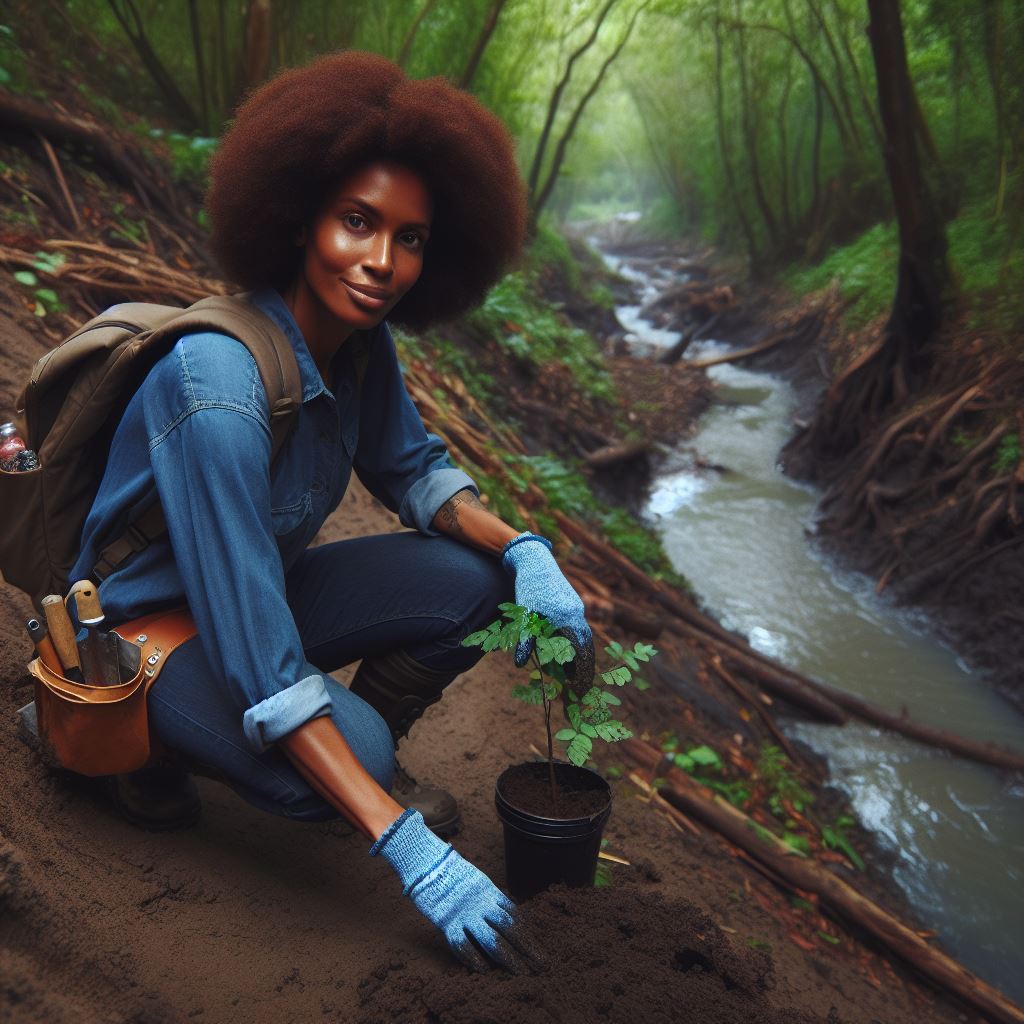Introduction
Let’s explore Emerging Trends in Conservation Science.
A brief explanation of conservation science
Conservation science plays a vital role in understanding and protecting Earth’s natural resources.
As new challenges arise, it is crucial for conservationists to stay updated on emerging trends.
Importance of staying updated on emerging trends
By staying informed, researchers can develop effective strategies to address conservation issues.
One emerging trend in conservation science is the use of advanced technology.
Unmanned aerial vehicles, for example, allow researchers to monitor wildlife populations and habitats more efficiently.
Another emerging trend is the application of genomics in conservation efforts.
Scientists are using genetic information to track population dynamics, identify vulnerable species, and implement targeted conservation measures.
Climate change is also driving emerging trends in conservation science.
Researchers are studying the impacts of climate change on ecosystems and developing strategies to mitigate its effects.
Furthermore, there is a growing emphasis on community-based conservation approaches.
Recognizing the importance of involving local communities, conservation efforts now focus on collaboration and empowerment.
Thesis statement: This blog post explores the emerging trends in conservation science and their implications
The implications of these emerging trends are significant.
They offer new opportunities for more effective and efficient conservation strategies.
By embracing technology, incorporating genomics, addressing climate change, and promoting community involvement,
Conservation science can make a greater impact in protecting our planet’s biodiversity and natural resources.
Generally, understanding and embracing emerging trends in conservation science is crucial for effective conservation efforts.
By staying updated, researchers can address new challenges and develop innovative solutions for a sustainable future.
Overview of Conservation Science
Definition and scope of conservation science
Conservation science refers to the interdisciplinary field that aims to understand and protect the natural world.
Conservation science is an interdisciplinary field that encompasses the study of various aspects of the natural world.
It aims to understand and protect the Earth’s biodiversity, ecosystems, and natural resources.
The field encompasses a wide range of disciplines, including biology, ecology, genetics, sociology, economics, and policy.
Through scientific research, conservation scientists gather information about the natural world, analyze threats to biodiversity, and develop strategies for its preservation.
Conservation science also involves monitoring and assessing the effectiveness of conservation interventions.
By collecting data before and after implementing conservation measures, scientists can evaluate their impact and adjust their strategies accordingly.
Unlock Your Career Potential
Visualize a clear path to success with our tailored Career Consulting service. Personalized insights in just 1-3 days.
Get StartedThis adaptive management approach allows for continuous improvement in conservation practices.
Conservation science faces various challenges, including limited funding, political obstacles, and conflicting interests.
However, advancements in technology and interdisciplinary collaborations have expanded the scope and capacity of conservation science.
The field continues to evolve, incorporating new research methods, emerging technologies, and innovative conservation approaches.
Importance of scientific research in conservation efforts
Scientific research plays a crucial role in informing conservation strategies and decision-making processes.
Scientific research is an essential component of conservation efforts.
It provides the data needed to assess the status of ecosystems and species, identify threats, and develop effective conservation strategies.
By conducting research, scientists can gain a deeper understanding of ecological processes, species interactions, and the impacts of human activities on the environment.
One important aspect of conservation science is the use of technology and data analysis.
Scientists use advanced tools and techniques to collect and analyze data, enabling them to make informed decisions and prioritize conservation actions.
Remote sensing, geographic information systems (GIS), and satellite imagery are some of the technologies used to monitor habitat loss, deforestation, and climate change.
These tools provide essential information for conservation planning and management.
Another important aspect of conservation science is the integration of local knowledge and community engagement.
Collaborating with indigenous communities and local stakeholders can enhance the effectiveness and sustainability of conservation efforts.
Indigenous knowledge about the environment and traditional practices can provide valuable insights into ecological processes and resource management.
In addition to scientific research, conservation science also highlights the importance of policy and advocacy.
Conservation scientists work closely with policymakers and stakeholders to develop and implement conservation policies and regulations.
They provide scientific evidence to support policy decisions and raise awareness about the importance of biodiversity conservation.
Therefore, conservation science is a dynamic and interdisciplinary field that plays a crucial role in protecting the natural world.
Scientific research provides the foundation for conservation efforts, informing decision-making processes and guiding the development of effective strategies.
By integrating scientific knowledge, local communities, and policymakers, conservation science aims to preserve biodiversity and ensure the sustainability of ecosystems for future generations.
Read: Famous Canadian Conservationists
Emerging Technologies in Conservation Science
Use of remote sensing and satellite imagery
The use of remote sensing and satellite imagery has revolutionized conservation science.
These technologies allow scientists to monitor biodiversity and create accurate habitat maps.
Remote sensing technologies enable researchers to collect data from vast areas that are difficult to access on the ground.
Satellite imagery provides high-resolution images, allowing for detailed analysis of ecosystems.
These technologies have numerous applications in conservation.
They can track changes in land cover and monitor the distribution and abundance of species.
This information is crucial for effective conservation planning and decision-making.
However, remote sensing also has limitations.
Cloud cover can obstruct satellite images, affecting data collection.
Additionally, satellite imagery can be expensive to acquire and process, limiting its use in some areas.
Artificial intelligence and machine learning
Artificial intelligence (AI) and machine learning (ML) are increasingly being used in conservation science.
These technologies play a significant role in data analysis and modeling.
AI and ML algorithms can process large datasets quickly and extract meaningful patterns and relationships.
This enables scientists to gain valuable insights from complex ecological data.
Moreover, AI and ML have the potential for predictive modeling.
By analyzing historical data, these technologies can forecast future ecological trends and help in decision-making regarding conservation strategies.
For example, AI algorithms can predict the outcome of different management scenarios, aiding conservationists in selecting the most effective actions to preserve biodiversity.
DNA sequencing and genomics
DNA sequencing and genomics have revolutionized species identification and population monitoring in conservation science.
By analyzing an organism’s DNA, scientists can accurately identify species, including cryptic or morphologically similar ones.
This information is crucial for assessing species richness and biodiversity.
DNA sequencing also allows for the identification of individuals within populations, facilitating studies on population dynamics, gene flow, and relatedness.
Genetic diversity plays a vital role in conservation.
It ensures a resilient and adaptable population, enabling species to withstand environmental changes and disturbances.
Assessing and preserving genetic diversity is important for maintaining long-term species survival and supporting their ability to adapt to new challenges.
Lastly, emerging technologies in conservation science have revolutionized the field.
Remote sensing and satellite imagery provide valuable data for monitoring biodiversity and habitat mapping.
Artificial intelligence and machine learning enable efficient data analysis and predictive modeling, aiding decision-making.
DNA sequencing and genomics improve species identification and help preserve genetic diversity, ensuring long-term species survival.
Read: How to Become a Conservation Scientist

Innovative Approaches in Conservation Science
Community-based conservation
Importance of involving local communities in conservation efforts
Conservation efforts are most effective when local communities are actively involved.
These communities have a deep understanding of the land, resources, and biodiversity in their area.
Their traditional knowledge and expertise can contribute significantly to the success of conservation initiatives.
Furthermore, involving local communities fosters a sense of ownership and responsibility, leading to the long-term protection of natural resources.
Examples of successful community-based projects
Many successful community-based conservation projects have been implemented worldwide.
One notable example is the Community Conserved Areas (CCAs) in India.
Local communities in various regions have established CCAs to protect forests, wildlife, and ecosystems.
These initiatives have not only preserved biodiversity but also improved the livelihoods of the communities involved through sustainable resource management.
Another example is the Co-management Agreements in Namibia, where local communities collaborate with the government to manage wildlife and share the benefits of conservation tourism.
Conservation finance
Introduction to new funding mechanisms such as impact investing
Traditional funding sources for conservation science are often insufficient to address the scale of current conservation challenges.
To bridge this gap, innovative funding mechanisms like impact investing have emerged.
Impact investing involves providing financial support to projects that aim to generate both environmental and social returns.
It attracts private investors who are interested in aligning their financial investments with conservation goals.
Role of private sector and philanthropy in funding conservation initiatives
The private sector and philanthropic organizations play a critical role in funding conservation initiatives.
Corporations are increasingly recognizing the importance of sustainability and investing in environmental conservation projects.
Through corporate social responsibility efforts and partnerships with conservation organizations, they contribute significant financial resources.
Similarly, philanthropic organizations provide grants and donations to support research, conservation programs, and the development of innovative conservation technologies.
Conservation technology
Adoption of advanced monitoring devices and sensors
The adoption of advanced monitoring devices and sensors has revolutionized conservation practices.
These technologies allow for real-time data collection on biodiversity, environmental parameters, and threats to ecosystems.
Remote sensing techniques, including the use of satellite imagery, provide valuable information on deforestation, land use changes, and habitat fragmentation.
Acoustic monitoring devices help in tracking wildlife populations and studying their behavior.
Examples of technology aiding conservation efforts
Technology has significantly aided conservation efforts across the globe.
Unmanned aerial vehicles (UAVs) equipped with cameras and sensors are used to monitor wildlife populations in remote areas and detect illegal activities.
Camera traps, equipped with motion sensors, capture images of elusive and endangered species, aiding in their identification and protection.
DNA fingerprinting techniques enable the tracking of wildlife trade and poaching.
Additionally, data analytics and machine learning are being utilized to analyze large datasets and develop effective conservation strategies.
Read: A Guide to Starting a Farm in Canada
Challenges and Opportunities in Conservation Science
Conservation science plays a crucial role in the protection and preservation of our planet’s biodiversity.
As emerging trends in this field continue to evolve, it is important to address the challenges and opportunities that arise.
A significant challenge in conservation science is the ethical considerations and potential misuse of emerging technologies.
From genetic engineering to drone surveillance, novel approaches can provide valuable insights but must be used responsibly to avoid unintended consequences.
Furthermore, the need for interdisciplinary collaboration and knowledge sharing is imperative in addressing complex conservation issues.
By engaging experts from diverse fields such as biology, ecology, sociology, and economics, a comprehensive understanding of the interconnectedness of ecological systems can be achieved.
Opportunities arise for international cooperation and partnerships in conservation science.
Collaboration between countries enables the sharing of resources, expertise, and data, leading to more effective conservation strategies on a global scale.
By working together, we can overcome barriers and achieve holistic solutions.
Additionally, policy and advocacy play a pivotal role in promoting conservation science.
Robust policies that enforce sustainable practices and protect endangered species are essential.
Furthermore, advocacy efforts can create public awareness and garner support for conservation initiatives.
Ethical considerations and potential misuse of emerging technologies
The advancement of technology has opened up new possibilities for conservation science.
However, it also raises ethical concerns that need to be carefully addressed.
The misuse of these emerging technologies can have severe consequences for the environment and ecosystem health.
Policies should be in place to regulate the use of such technologies and prevent any potential harm.
Need for interdisciplinary collaboration and knowledge sharing
Conservation science requires a multidisciplinary approach to tackle complex environmental challenges.
Collaboration among scientists, policymakers, and local communities is essential for sharing knowledge and expertise.
By bridging gaps between different disciplines, we can develop innovative and effective conservation strategies.
Opportunities for international cooperation and partnerships
Conservation efforts should not be confined to national boundaries.
International cooperation and partnerships can lead to more comprehensive and efficient conservation initiatives.
By pooling resources, sharing best practices, and promoting joint research, countries can address global environmental concerns collectively.
Importance of policy and advocacy in promoting conservation science
Policies and advocacy play a crucial role in promoting conservation science.
Governments need to enact and enforce legislation that supports sustainable practices and the protection of biodiversity.
Advocacy efforts are also essential in raising public awareness, mobilizing support, and fostering a culture of environmental stewardship.
In general, the challenges and opportunities in conservation science are vast.
Ethical considerations and responsible use of emerging technologies, interdisciplinary collaboration, international cooperation, and policy advocacy are all vital aspects of ensuring the continued success of this field.
By actively addressing these challenges and embracing the opportunities, we can work towards a more sustainable and biodiverse future for our planet.
Read: Canadian Farming Subsidies Explained
See Related Content: Day in the Life of a Conservation Scientist
Conclusion
Recap of the emerging trends discussed in the blog post
Throughout this blog post, we explored several emerging trends in conservation science.
We first discussed the importance of incorporating artificial intelligence and machine learning techniques into conservation research.
These technologies have the potential to greatly enhance data analysis and decision-making processes in conservation efforts.
Next, we examined the growing use of genomics and DNA barcoding in studying and protecting endangered species.
These tools provide researchers with valuable insights into biodiversity and help in the identification and preservation of threatened species.
Additionally, we explored the rise of citizen science projects in conservation.
Engaging the public in data collection and analysis not only produces a vast amount of data but also raises awareness and fosters a sense of environmental stewardship.
We also highlighted the significance of integrating Indigenous knowledge and practices into conservation science.
Collaborating with Indigenous communities ensures that conservation efforts respect and incorporate their traditional ecological knowledge, enhancing the effectiveness and sustainability of conservation projects.
Call to action for individuals interested in conservation science
If you are passionate about conservation science and want to contribute, there are several ways to get involved.
You can join citizen science initiatives or volunteer in local conservation projects.
Consider pursuing a career in conservation research or supporting organizations dedicated to preserving biodiversity.
Closing thoughts on the future of conservation science
As we look towards the future, the field of conservation science holds great promise.
By leveraging technology, embracing diverse perspectives, and engaging the public, we can tackle the growing challenges facing our planet.
Through collaborative efforts, we can ensure the long-term sustainability and protection of biodiversity for generations to come.
Together, we can make a difference in the world of conservation science.




